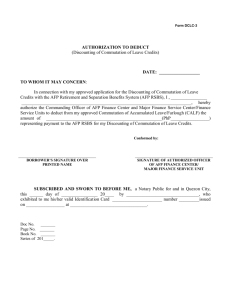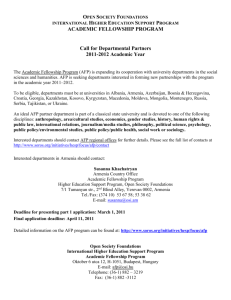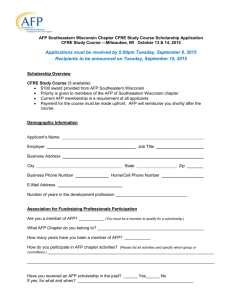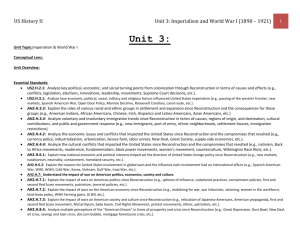Addendum: American History II:
advertisement
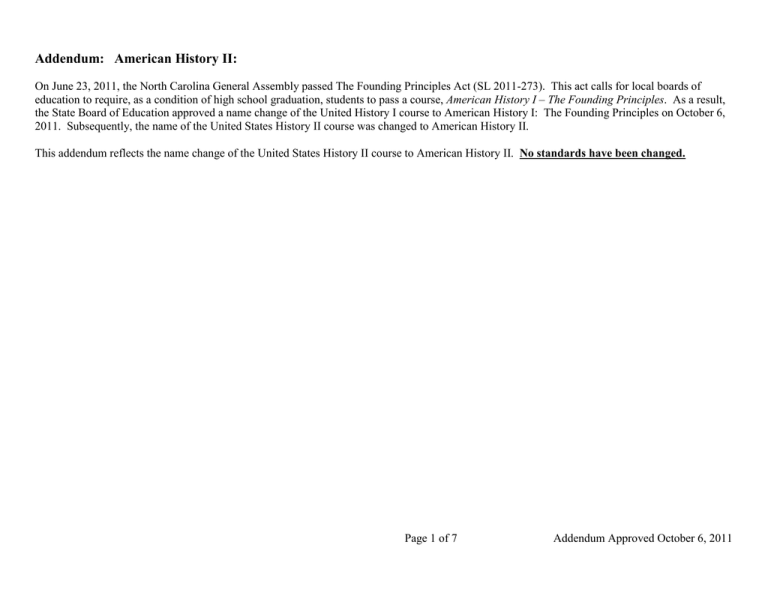
Addendum: American History II: On June 23, 2011, the North Carolina General Assembly passed The Founding Principles Act (SL 2011-273). This act calls for local boards of education to require, as a condition of high school graduation, students to pass a course, American History I – The Founding Principles. As a result, the State Board of Education approved a name change of the United History I course to American History I: The Founding Principles on October 6, 2011. Subsequently, the name of the United States History II course was changed to American History II. This addendum reflects the name change of the United States History II course to American History II. No standards have been changed. Page 1 of 7 Addendum Approved October 6, 2011 North Carolina Essential Standards Social Studies - American History Course II There will be two required United States History courses at the high school level. American History Course I will begin with the European exploration of the new world through Reconstruction. Students will examine the historical and intellectual origins of the United States from European exploration and colonial settlement to the Revolutionary and Constitutional eras. Students will learn about the important political and economic factors that contributed to the development of colonial America and the outbreak of the American Revolution as well as the consequences of the Revolution, including the writing and key ideas of the U.S. Constitution. American History Course I will guide students as they study the establishment of political parties, America’s westward expansion, the growth of sectional conflict, how that sectional conflict led to the Civil War, and the consequences of the Civil War, including Reconstruction. American History Course II will guide students from the late nineteenth century time period through the early 21st century. Students will examine the political, economic, social and cultural development of the United States from the end of the Reconstruction era to present times. The essential standards of American History Course II will trace the change in the ethnic composition of American society; the movement toward equal rights for racial minorities and women; and the role of the United States as a major world power. An emphasis is placed on the expanding role of the federal government and federal courts as well as the continuing tension between the individual and the state. The desired outcome of this course is for students to develop an understanding of the cause-and-effect relationship between past and present events, recognize patterns of interactions, and understand the impact of events on in the United States in an interconnected world. The essential standards of this course have been designed to provide a framework for studying political, social, economic, and cultural issues, and for analyzing the impact these issues have had on American society over time. Students will continue to build upon previous studies of American History, the fundamental concepts in civics and government, economics, culture and geography taught in grades kindergarten through eight and use skills of historical analysis as they examine American history. This course goes beyond memorization of isolated facts to the development of higher level thinking skills, encouraging students to make historical assessments and evaluations. For example, students will study key turning points that helped shape the United States. Examples of specific turning points as well as other critical content will be provided in an Instructional Toolkit of support material that will be developed to help guide teachers with greater explanation of content possibilities, Revised Bloom’s Taxonomy, instructional activities, formative assessments, additional resources and professional development. The essential standards for this course have been developed to serve as the framework that will guide each local school district in the development of the curriculum for their standard and honors level American History courses and are not intended to be the curriculum, nor do they indicate the whole of the curriculum that will be written by an LEA. Written conceptually, standards for this course have been developed with an historical approach and identify the most critical knowledge and skills that students need to learn in this course. The Essential Standards for this course have been written using the Revised Bloom's Taxonomy (RBT).The use of RBT as well as conceptually written standards are a combination that will help to ensure students successfully achieve the mission of the North Carolina State Board of Education: “Every public school student will graduate from high school, globally competitive for work and postsecondary education and prepared for life in the 21st century.” Page 2 of 7 December 2, 2010 American History Course II Key to identifying strands: H-History History Essential Standard AH2.H.1 Apply the four interconnected dimensions of historical thinking to the American History Essential Standards in order to understand the creation and development of the United States over time. Clarifying Objectives AH2.H.1.1 Use Chronological thinking to: 1. Identify the structure of a historical narrative or story: (its beginning, middle and end) 2. Interpret data presented in timelines and create timelines. AH2.H.1.2 Use Historical Comprehension to: 1. Reconstruct the literal meaning of a historical passage. 2. Differentiate between historical facts and historical interpretations. 3. Analyze data in historical maps. 4. Analyze visual, literary and musical sources. AH2.H.1.3 Use Historical Analysis and Interpretation to: 1. Identify issues and problems of the past. 2. Consider multiple perspectives of various peoples of the past. 3. Analyze cause-and-effect relationships and multiple causation. 4. Evaluate competing historical narratives and debates among historians. 5. Evaluate the influence of the past on contemporary issues. AH2.H.1.4 Use Historical Research to: 1. Formulate historical questions. 2. Obtain historical data from a variety of sources. 3. Support interpretations with historical evidence. 4. Construct analytical essays using historical evidence to support arguments. Page 3 of 7 December 2, 2010 History Essential Standard AH2.H.2 AH2.H.3 Clarifying Objectives Analyze key political, economic and social turning points in American History using historical thinking. AH2.H.2.1 Analyze key political, economic, and social turning points since the end of Reconstruction in terms of causes and effects (e.g., conflicts, legislation, elections, innovations, leadership, movements, Supreme Court decisions, etc.). AH2.H.2.2 Evaluate key turning points since the end of Reconstruction in terms of their lasting impact (e.g., conflicts, legislation, elections, innovations, leadership, movements, Supreme Court decisions, etc.). Understand the factors that led to exploration, settlement, movement, and expansion and their impact on United States development over time. AH2.H.3.1 Analyze how economic, political, social, military and religious factors influenced United States imperialism (e.g., passing of the western frontier, new markets, Spanish American War, Open Door Policy, Monroe Doctrine, Roosevelt Corollary, canal routes, etc.). AH2.H.3.2 Explain how environmental, cultural and economic factors influenced the patterns of migration and settlement within the United States since the end of Reconstruction (e.g., gold rush, destruction of the buffalo, reservations, ethnic neighborhoods, etc.). AH2.H.3.3 Explain the roles of various racial and ethnic groups in settlement and expansion since Reconstruction and the consequences for those groups (e.g., American Indians, African Americans, Chinese, Irish, Hispanics and Latino Americans, Asian Americans, etc.). AH2.H.3.4 Analyze voluntary and involuntary immigration trends since Reconstruction in terms of causes, regions of origin and destination, cultural contributions, and public and governmental response (e.g., new immigrants, ports of entry, ethnic neighborhoods, settlement houses, immigration restrictions, etc.). Page 4 of 7 December 2, 2010 History Essential Standard AH2.H.4 AH2.H.5 Clarifying Objectives Analyze how conflict AH2.H.4.1 and compromise have shaped politics, economics and culture in the United States. AH2.H.4.2 Analyze the political issues and conflicts that impacted the United States since Reconstruction and the compromises that resulted (e.g., Populism, Progressivism, working conditions and labor unrest, New Deal, Wilmington Race Riots, Eugenics, Civil Rights Movement, Anti-War protests, Watergate, etc.). Analyze the economic issues and conflicts that impacted the United States since Reconstruction and the compromises that resulted (e.g., currency policy, industrialization, urbanization, laissez-faire, labor unrest, New Deal, Great Society, supply-side economics, etc.). AH2.H.4.3 Analyze the social and religious conflicts, movements and reforms that impacted the United States since Reconstruction in terms of participants, strategies, opposition, and results (e.g., Prohibition, Social Darwinism, Eugenics, civil rights, anti-war protest, etc.). AH2.H.4.4 Analyze the cultural conflicts that impacted the United States since Reconstruction and the compromises that resulted (e.g., nativism, Back to Africa movement, modernism, fundamentalism, black power movement, women’s movement, counterculture, Wilmington Race Riots, etc.). Understand how AH2.H.5.1 tensions between freedom, equality and power have shaped the political, economic and social development of the AH2.H.5.2 United States. Summarize how the philosophical, ideological and/or religious views on freedom and equality contributed to the development of American political and economic systems since Reconstruction (e.g., “separate but equal”, Social Darwinism, social gospel, civil service system, suffrage, Harlem Renaissance, the Warren Court, Great Society programs, American Indian Movement, etc.). Explain how judicial, legislative and executive actions have affected the distribution of power between levels of government since Reconstruction (e.g., New Deal, Great Society, Civil Rights, etc.). Page 5 of 7 December 2, 2010 History Essential Standard AH2.H.6 AH2.H.7 AH2.H.8 Clarifying Objectives Understand how and why the role of the United States in the world has changed over time. AH2.H.6.1 Explain how national economic and political interests helped set the direction of United States foreign policy since Reconstruction (e.g., new markets, isolationism, neutrality, containment, homeland security, etc.). AH2.H.6.2 Explain the reasons for United States involvement in global wars and the influence each involvement had on international affairs (e.g., Spanish-American War, WWI, WWII, Cold War, Korea, Vietnam, Gulf War, Iraqi War, etc.). Understand the impact of war on American politics, economics, society and culture. AH2.H.7.1 Explain the impact of wars on American politics since Reconstruction (e.g., spheres of influence, isolationist practices, containment policies, first and second Red Scare movements, patriotism, terrorist policies, etc.). AH2.H.7.2 Explain the impact of wars on the American economy since Reconstruction (e.g., mobilizing for war, war industries, rationing, women in the workforce, lend-lease policy, WWII farming gains, GI Bill, etc.). AH2.H.7.3 Explain the impact of wars on American society and culture since Reconstruction (e.g., relocation of Japanese Americans, American propaganda, first and second Red Scare movement, McCarthyism, baby boom, Civil Rights Movement, protest movements, ethnic, patriotism, etc.). Analyze the relationship between innovation, economic development, progress and various perceptions of the “American Dream” since Reconstruction (e.g., Gilded Age, assembly line, transcontinental railroad, highway system, credit, etc.). Analyze the relationship between progress, crisis and the “American Dream” within the United States. AH2.H.8.1 AH2.H.8.2 Explain how opportunity and mobility impacted various groups within American society since Reconstruction (e.g., Americanization movement, settlement house movement, Dust Bowl, the Great Migration, suburbia, etc.). Page 6 of 7 December 2, 2010 History Essential Standard Clarifying Objectives AH2.H.8.3 Evaluate the extent to which a variety of groups and individuals have had opportunity to attain their perception of the “American Dream” since Reconstruction (e.g., immigrants, Flappers, Rosie the Riveter, GIs, blue collar worker, white collar worker, etc.). AH2.H.8.4 Analyze multiple perceptions of the “American Dream” in times of prosperity and crisis since Reconstruction (e.g., Great Depression, Dust Bowl, New Deal, oil crisis, savings and loan crisis, dot.com bubble, mortgage foreclosure crisis, etc.). Page 7 of 7 December 2, 2010
